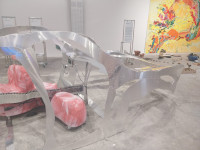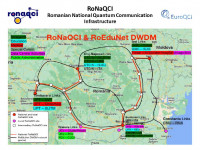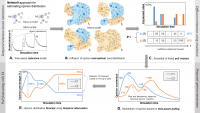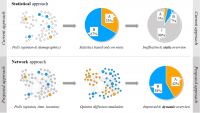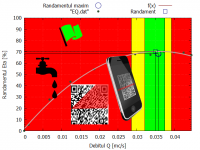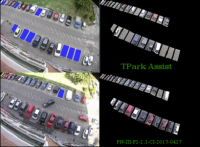Research Projects
HRIA: Romanian Artificial Intelligence Hub
The general objective of the project is to create and operationalize the Romanian Artificial Intelligence Hub (HRIA) for research, development and innovation in the field of Artificial Intelligence (AI) by developing an attractive and competitive research ecosystem that brings together the efforts of academia and the economic environment, in order to create original scientific research, transfer research results to industry and society, develop new products and services, and generate a core of knowledge and development in Artificial Intelligence integrated into the European Research Area (ERA).
The HRIA project will develop an ecosystem of excellence in Artificial Intelligence which, through the objectives and results obtained, will be unique in Romania in terms of the scope of research-development-innovation activities and results with concrete impact in the economy. HRIA will allow the coagulation of the efforts of the Romanian AI community in order to increase the impact at European and global level, becoming the catalyst of this process, creating national resources for development and innovation in the field of AI and supporting all sectors of the community. The HRIA project has the capacity to reach the critical mass of researchers and the necessary infrastructure to form a strong AI ecosystem, acting as an attractor and focal point of national efforts in the field of artificial intelligence, increasing the scientific potential in the country and developing market-ready artificial intelligence technologies, usable in several sectors.
Specific objectives:
O1. Development of the AI area in Romania by producing and stimulating the research of excellence, the application-oriented research, the innovation and interdisciplinary research, at international standards.
Results of this objective: New AI technologies, models, methods and algorithms, original and innovative system prototypes and AI-based services, in the areas of interest covered by HRIA.
O2. Collaboration with the companies to transfer the AI research results in the industry and to consistently introduce the AI technologies in the Romanian economy.
Results of this objective: Increase of the innovation capacity of Romanian companies through the introduction of the AI in the product and process innovation, as well as through the development of AI-based pilot projects and applications.
O3. Development of highly specialized human resource, including the attraction and recruitment of new generation AI specialists and top AI experts from Romania, from the diaspora and abroad, as well as the training of new research talents in the area.
Results of this objective: Highly specialized researchers in AI.
O4. Development of a research infrastructure at international standards and its efficient use to support the research, development and innovation objectives of HRIA.
Results of this objective: High performance computing and AI processing infrastructure.
O5. Increase of the international visibility of the Romanian AI research, and of the capacity of Romanian researchers to be actively involved in the European collaboration and the EU research networks of excellence.
Results of this objective: High visibility of Romanian researchers at European and international levels, active Romanian involvement in Europe Horizon projects and other major international projects, and the integration of Romania in the European Research Area (ERA).
Bogdan GROZA, Cătălin CĂLEANU, Octavian ȘTEFAN, Adrian KORODI, Pal-Stefan MURVAY, Horatiu GURBAN, Marian BUCOS, Bogdan DRĂGULESCU, Georgiana ȚUCUDEAN, Mihai URSAN, Alfred ANISTOROAIEI, Patricia IOSIF, Eduard HOGEA, Traian PLOSCA, Andrei NICOLAE, Alexandra BASSO-TIDREA, Alexandru BABALAU, Adriana BIRTEA, Raluca PACIOAGA, Ana JURCHESCU, Simona FILIPAȘ, Nicolina ADAMESCU, Roxana SÎRBU, Irena MOCIOFAN

6Sol(T6) - Innovative Systems and Equipment for the Implementation of Authorized Measures from National Security Mandates
Project Code: PN-IV-P6-6.3-SOL-2024-2-0265
Description:
The project aims to provide an efficient response to the challenges generated by the evolution of the national security context, through the development and validation of innovative technical solutions with covert use in the operational environment, necessary for the collection, monitoring and management of data of interest at a high quantitative and qualitative level.
General Objective:
Development of an innovative facility (infrastructure) for:
a) Implementation of technical solutions in compliance with the requirements imposed by the specific activities carried out to optimize and streamline activities in the context of implementing authorized national security measures.
b) Deployment of concealed equipment, depending on operational particularities, with real-time data and information transmission capabilities, through the intermediate of being processed and analyzed, in order to generate synthesis reports necessary for documenting aspects of interest.
c) Consolidation of the beneficiary's technical capabilities, as well as the possibility of generating information exchanges with partners with attributions in the national security sphere.
Activities:
- Solution study regarding the identification and establishment of technologies / equipment / methods / means / concepts suitable for the development of specific technical equipment complex (CTAS).
- Concept definition and establishment of the basic CTAS architecture (hardware and software).
- Prototype design / prototype batch / CTAS modules. Hardware and software module design. Preliminary execution documentation preparation.
- Implementation of CTAS modules / components (hardware and software).
- Testing of components / modules / prototypes in laboratory conditions and in real operational scenarios. Optimization - refinement, sequence repetition.
- CTAS system assembly integration.
- Testing-validation in real operational conditions of the CTAS system prototype, at the beneficiary.
- Finalization of CTAS prototype + execution documentation.
- User training (beneficiary user personnel).
Expected Results:
1 pc. innovative audio-video HW&SW technical solution, functionally validated in real operational scenarios, fully compliant with the specifications of the reference terms.
Florin ALEXA, Teodor PETRIȚA,
Bright Cityscapes - Synthia Project
Synthia is a design installation created by the designer Flora Lechner in collaboration with the researcher Cristina Stângaciu. It represents an artistic view of DSPLabs research projects related to the automotive industry.
RoNaQCI: Romanian National Quantum Communication Infrastructure
RoNaQCI proposes the deployment of a 1500+ km QCI network including 6 metropolitan networks in the cities of Bucharest, Iasi, Cluj-Napoca, Timisoara, Craiova and Constanta, with 36 QKD links spanning Romania and connecting 10 universities, 5 research institutes, 5 public bodies, 3 data centers and a medical clinic, and with future links planned for quantum Internet interconnecting with neighbors.
The project will be implemented by a consortium lead by UPB, the largest technical university in Romania and with key infrastructure support from RoEduNet who manages the 6000+ km Romanian network for education and research. The consortium benefits from multi-disciplinary expertise of 30 partners: 12 universities, 7 research institutes, 3 national agencies, 3 companies and 5 relevant stakeholders. It includes both Romanian participants to QuantERA and 10/14 partners from all Romanian quantum communication projects (QUTECH-RO, QSTRAT, QUANTEC).
RoNaQCI will provide both upskilling and technology testbeds, establishing a national network of quantum communication technology (QCT) hubs. Through them, RoNaQCI will produce a national QCT training and education standard. This includes the development of a standard QCT certification and organizing workshops and training sessions to deliver a large number of trained users in academia, public bodies and industry including internet service providers.
RoNaQCI will develop and contribute to open source software for QCI monitoring and exploitation including security certificates, VPN and SSH. RoNaQCI software will be used for QCI testing, for 15 metropolitan advanced use cases on medical, financial and big data, public administration, research and special communication and for 2 national use cases on education and special communication.
RoNaQCI is developed in partnership with national institutions such as the Romanian Naval Authority, the National Ministry of Education and the National Ministry of Defense.
Sebastian Mihai ARDELEAN, Marinela POPESCU
PollStream: Agent-based interaction models with temporal attenuation for opinion poll prediction
The dynamics of social networks, namely the way connections are created and strengthened between individuals, is a very complicated process with many factors interfering in the emergence and evolution of social ties. Current research tries to better explain the high complexity of such network structures, by proposing corresponding algorithmic models for the evolution of topologies and influence propagation. Nevertheless, state of the art models have multiple limitations, as they typically make simplifying assumptions about opinion interaction mechanisms with fixed thresholds, non-dynamic topologies, or pervasive opinion sources.
This project comes to push the boundaries of scientific understanding forward, on several levels, by placing novel and existing pieces of the puzzle together, in terms of better predicting the spread of opinion over large social temporal networks. The main objectives of this project are:
- To define an original temporal agent-based interaction model (with a dynamic time-aware threshold);
- To explore and define, through mathematical modeling and computer simulation, novel trade-off strategies for improving opinion diffusion coverage, while maintaining a minimal cost of operation for engaged spreader agents;
- To improve the prediction accuracy of opinion distribution by integrating the temporal attenuation paradigm, with direct applicability in electoral poll forecasting;
- To combine the obtained interaction model, with diffusion strategies, and temporal poll prediction into a simulator application for defining a robust opinion poll prediction framework.
The motivation of these research goals is supported by the social and economic impact potential of the project. Namely, inferring the underlying dynamics of social interaction is of outstanding present interest, since it has direct applicability in viral marketing, political science, and even epidemiology, for predicting the spread of a commercial, a rumor, or a virus.
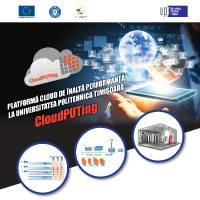
CloudPUTing: High Performance Cloud Platform at Politehnica University of Timisoara
The aim of the project is to increase the research and innovation capacity of UPT by creating a high-performance, heterogenous, energy efficient, private cloud computing node based on open technologies, which is connected to national and international networks of research cloud infrastructures, and which has direct applicability in the collection, storage, analysis, distribution and the protection of the massive data produced by the research and innovation initiatives carried out in the western region of Romania.
The main target group of the project consists of all the UPT researchers and PhD students, regardless of the research field in which they operate, who can benefit from the services provided by IT-specific tools, provided in the form of centralized computing services, storage and productivity. The project also targets public and private research partners which collaborate with the UPT at local, national and international level.
Objectives:
- Implementation of an energy-efficient, HPC-type of computing and data storage infrastructure to provide flexible to manage and resource scalable virtual environments
- Implementation of a large capacity data collection, storage and interchange platform, to be provided as a service (PaaS - Platform as a Service). Three categories of specific data are considered for validating this implementation: (a) crowdsourcing/ IoT type of data, (b) multimedia type of data and (c) geographical type of data
- Implementation of a platform for cloud-based functions (FaaS - Function as a Service), for data processing and analysis. The project also includes the implementation of a demo deep learning application for the intelligent selection of a subset of images (at least 1M images), based on diversity estimation
- Implementation of a local solution for managing and storing of the personal data which results from the research and innovation activities within UPT, according to the new GDPR standards
An overview of the hardware implementation results, from the perspective of the nodes assembly and their capabilities, including the storage and FPGA nodes:
- Total of processing and storage nodes: 19
- Total of processing and storage cores: 352
- Total memory capacity: 4000 GB
- Total storage capacity; 598 TB (raw), 417 TB (usable)
- Node connectivity: 40 Gbps
- GPU boards: 4 x NVIDIA Tesla T4 16GB, Passive, Single Wide, Full Height GPU
- FPGA modules:
- 2 x Intel FPGA PAC with Arria10 GX, 70W FH
- 2 x Intel PAC D5005, Stratix10, 32GB, 215W, Double Wide, Full Height, QSFP28 FPGA
Daniel IERCAN, Claudia MICEA, Mihaela CIULEANU, Ana JURCHESCU
IMPRESS: IMproving the PREdiction of opinion dynamics in temporal Social networks: mathematical modeling and Simulation framework
In a rapidly evolving world, with growing population and accelerated access to online media, the need to understand the structures and behavior of human society has become more important than ever. Having emerged as an interdisciplinary field in the 21st century, social networks analysis is on the quest to understand opinion formation and diffusion from a scientific point of view. The formation of social networks, namely the way connections are created and strengthened, is a very complex process, and there are many factors that interfere for the emergence and evolution of social ties. Notable research efforts try to explain the high complexity of such network structures, by proposing corresponding algorithmic models. Nevertheless, available models have many limitations as they typically assume opinion interaction mechanisms based on fixed thresholds, static topologies, or omnipresent opinion sources.
This project comes to improve our understanding of opinion diffusion in emergent social networks. Consequently, to build models that are aware of these phenomena, I propose fundamental topological analysis of empirical data - using network motifs, community detection algorithms and statistics - to understand the behavioral patterns and centralities which have an impact on spatial and temporal distribution of opinion. As opposed to most existing opinion interaction models, I propose a temporal opinion injection model which evolves over time according to basic human traits and underlying social topology. Also, by employing discrete event simulation on real-time gathered social network data, I propose the implementation of an online platform to offer improved prediction on poll outcomes for socially-relevant topics.
In the wake of big data analytics, this project sets out to push the boundaries of scientific understanding of opinion dynamics in social networks by analyzing how the underlying network topology influences communication patterns and polarization of opinion.
Software Module for Efficiency Assessment of the Hydraulic Pumps in Service for Drinkable Water Systems
A software tool (desktop and mobile) has been developed for the efficiency assessment of hydraulic generators' operation installed in Timisoara's drinkable water system and beyond. The diagnostic is computed based on QR codes and the traffic light system using three colors: green, for normal operation, yellow, for dangerous operation which requires a planned stop and finally red, for abnormal operation requiring an emergency halt.
The diagnostic system has been validated using laboratory experiments and several selected pumps in service for daylight and nighttime use at AQUATIM. Timisoara has more than 300.000 inhabitants, 30.000 foreign students and several hundreds km of pipes delivering drinkable water to the citizens.
The Principal Investigator of the project was interviewed by TeleU about the project results in this video clip:
Eng. Daniel Calin MOS, Faculty of Mechanics, Politehnica University Timisoara (project member)
In-situ measurement team for daylight and nighttime service (volunteering students): Ardelean TIMOTEI, Szakal RAUL, Alexandra PETER, Bogdan KADLECZ, Alexandru MARAN
TPark Assist: Parking assistance system for TPark
The objective of this project is to extend the services offered to the clients by the Piconet company, which is the national leader of city surface parking management systems. The aim is to develop a robust method for monitoring the parking occupancy based on processing of images captured by surveillance cameras. This method has to adapt to harsh weather conditions and to changing in illumination due to some natural causes like clouds or artificial ones like public lighting. It also has to adapt to a large variety of cameras’ deployment angles, and to learn environment changes. It has to offer a good support for future extension of services – e.g. automatic car plates recognition or automatic payment methods.
The company plan to use the method developed here to implement a mobile application that can offer an overview of parking occupancy to the clients for an entire area managed by the company. The utility of this solution is to save the client time spent in finding a parking place, especially in crowded central city areas, and it was already requested by many existing clients. Moreover, it will ensure some other benefits like saving the fuel consumption and reducing the pollution generated by cars that creates overhead traffic on the way to find a free parking place. In order to ensure the desired accuracy this method will combine image processing algorithms with existing statistical information collected by the company, and with learned data. In addition it should include a simple and clear procedure for further system deployment.
The result of research will be a functional prototype that can be integrated in the existing company parking management system.
INCEPTION: Internet of Things meets Complex Networks or early prediction and management of Chronic Obstructive Pulmonary Disease
Recent research indicates Chronic Obstructive Pulmonary Disease (COPD) as the third cause of death and one of the main impediments to the quality of living in today’s society. COPD is defined as the clinical condition which reduces pulmonary capacity; it is not reversible, however if diagnosed at an early phase, its evolution can be controlled. Unfortunately, the early detection of COPD is a difficult task, and often time people are diagnosed when they are already in an advanced stage.
Capitalizing on recent research results which indicate sensor systems, mobile, and Internet of Things solutions as very useful for monitoring and managing COPD, we propose a personal, integrated prototype system for early detection and evolution prediction of COPD. As such, we intend to build a sensor network that gathers multiple physiological signals and a mobile application that extracts the multi-fractal spectra as mere signatures of these signals. Then, the mobile system will integrate the physiologic signatures with anthropometric and other individual clinical data. On the server side, we will collect the integrated data from a population of individuals, to build a complex network model of patients. Indeed, recent papers indicate the complex network model as very useful for generating COPD predictions. To this end, we will employ modularity clustering and network layout tools to build prediction models for both early detection and evolution prediction of COPD. The prediction model will be instantiated as a smartphone application and tested in order to assess its predictive capacity.
In order to undertake the objectives of our proposal, we assemble a multidisciplinary team, consisting of computer engineers (hardware and software) and specialized medical doctors. The engineering teams will build the hardware and software parts of our demonstration model, whereas the medical team will provide the necessary medical expertise, in order to test and validate the engineering model.
Andrei LIHU, Ștefan MIHĂICUȚĂ, Daniela REISZ, Rodica DAN, Carmen ARDELEAN




